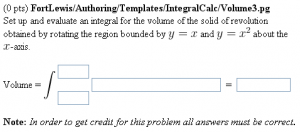Difference between revisions of "Volume3"
Jump to navigation
Jump to search
Paultpearson (talk | contribs) m |
Paultpearson (talk | contribs) |
||
| Line 5: | Line 5: | ||
This PG code shows how to ask students to set up a volume of solids of revolution integral in which all parts must be correct for the student to receive any credit. |
This PG code shows how to ask students to set up a volume of solids of revolution integral in which all parts must be correct for the student to receive any credit. |
||
</p> |
</p> |
||
| − | * Download file: [[File:Volume3.txt]] (change the file extension from txt to pg when you save it) |
||
| + | * File location in OPL: [https://github.com/openwebwork/webwork-open-problem-library/blob/master/OpenProblemLibrary/FortLewis/Authoring/Templates/IntegralCalc/Volume3.pg FortLewis/Authoring/Templates/IntegralCalc/Volume3.pg] |
||
| − | * File location in NPL: <code>FortLewis/Authoring/Templates/IntegralCalc/Volume3.pg</code> |
||
<br clear="all" /> |
<br clear="all" /> |
||
| Line 179: | Line 178: | ||
Context()->texStrings; |
Context()->texStrings; |
||
BEGIN_SOLUTION |
BEGIN_SOLUTION |
||
| − | ${PAR}SOLUTION:${PAR} |
||
Solution explanation goes here. |
Solution explanation goes here. |
||
END_SOLUTION |
END_SOLUTION |
||
Revision as of 17:03, 16 June 2013
A Question That Provides Credit Only When All Answers Are Correct
This PG code shows how to ask students to set up a volume of solids of revolution integral in which all parts must be correct for the student to receive any credit.
- File location in OPL: FortLewis/Authoring/Templates/IntegralCalc/Volume3.pg
| PG problem file | Explanation |
|---|---|
|
Problem tagging: |
|
DOCUMENT(); loadMacros( "PGstandard.pl", "MathObjects.pl", "PGunion.pl", "answerHints.pl", ); TEXT(beginproblem()); install_problem_grader(~~&std_problem_grader); $showPartialCorrectAnswers = 1; |
Initialization: We install the standard problem grader, which is an all-or-nothing grader. |
Context("Numeric");
Context()->variables->are(
x=>"Real", dx=>"Real",
y=>"Real", dy=>"Real"
);
$f = Compute("x");
$g = Compute("x^2");
$upper = Real("1");
$lower = Real("0");
# answers below are intentionally wrong
$int = Compute("( pi x - pi x^2 ) dx");
$vol = Compute("pi");
#
# Display the answer blanks properly in different modes
#
Context()->texStrings;
if ($displayMode eq 'TeX') {
$integral =
'Volume = \(\displaystyle' .
'\int_{'.
ans_rule(4). '}^{'.
ans_rule(4). '}'.
ans_rule(30). ' = '.
ans_rule(10).
'\)';
} else {
$integral =
BeginTable(center=>0).
Row([
'Volume = \(\displaystyle\int\)',
ans_rule(4).$BR.$BR.
ans_rule(4),
ans_rule(30).$SPACE.' = '.$SPACE.
ans_rule(10),
],separation=>2).
EndTable();
}
Context()->normalStrings;
|
Setup:
Notice that we use |
Context()->texStrings; BEGIN_TEXT Set up and evaluate an integral for the volume of the solid of revolution obtained by rotating the region bounded by \( y = $f \) and \( y = $g \) about the \(x\)-axis. $BR $BR $integral END_TEXT Context()->normalStrings; |
Main Text: The standard problem grader automatically provides a message to students that says the grading will be all or nothing. |
ANS( $upper->cmp() );
ANS( $lower->cmp() );
ANS( $int->cmp()
->withPostFilter(AnswerHints(
Formula("pi x - pi x^2 dx") => "Don't forget to multiply every
term in the integrand by dx",
Formula("pi x - pi x^2") => "Don't forget the differential dx",
Formula("(pi x^2 - pi x)*dx") => "Is the parabola above the line?",
Formula("pi x^2 - pi x") => "Is the parabola above the line?",
))
);
ANS( $vol->cmp() );
|
Answer Evaluation: |
Context()->texStrings;
BEGIN_SOLUTION
Solution explanation goes here.
END_SOLUTION
Context()->normalStrings;
COMMENT('MathObject version. Gives full credit only
if all answers are correct.');
ENDDOCUMENT();
|
Solution: |
